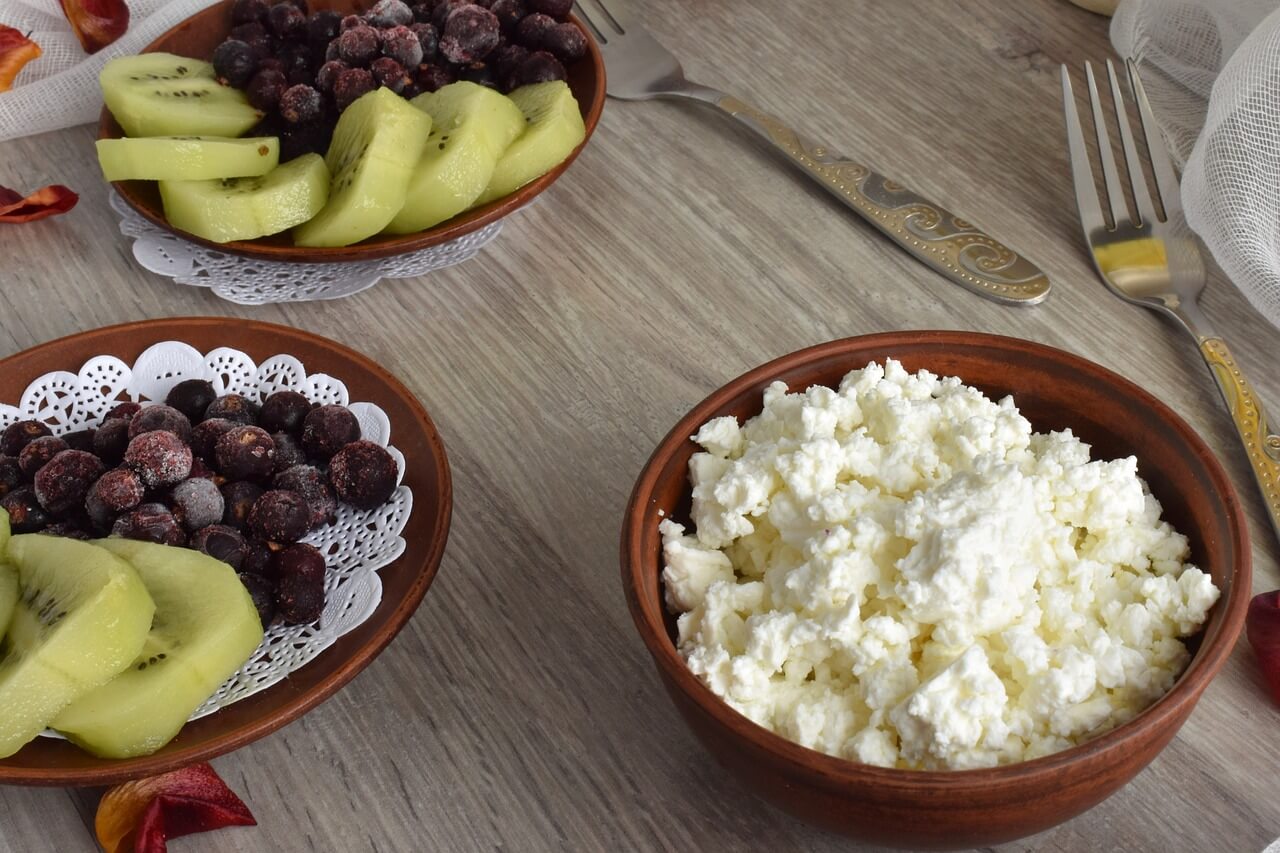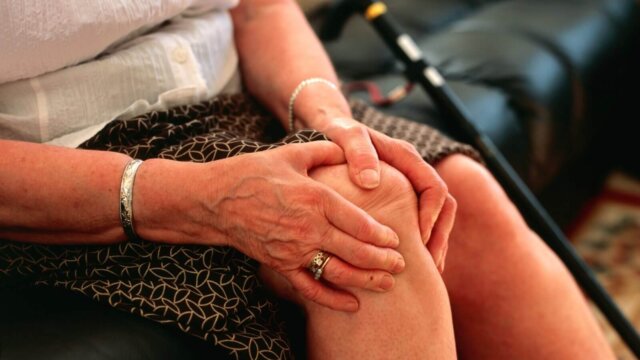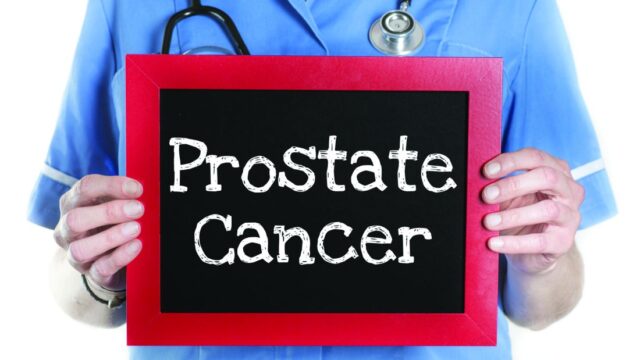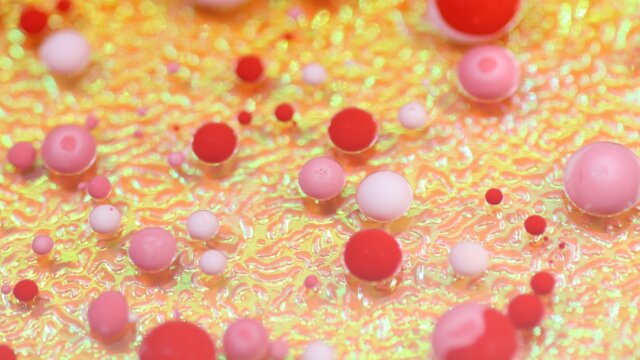FTC disclaimer: This post may contains affiliate links and we will be compensated if you click on a link and make a purchase.
Over many years, the Atkins Diet has been discussed, there have been many rumors and misconceptions that have been spread up.
It questions how effective the diet is and the health effects of consuming low carb foods.
There’s a lot of misinformation out there as to how the Atkins diet works. Granted, there is some controversy about the diet, and there are some drawbacks to the diet, but which diet doesn’t have detractors and downsides?
Ultimately though, because you aren’t hungry all the time, the Atkins Diet works much better than calorie-restricted diets.
What is Atkins Diet
Diets come and go in cycles, but few dietary programs have enjoyed the Atkins Diet or the Atkins Nutritional Approach’s popularity.
The highly controversial diet reached its peak in popularity during 2003 and 2004.
Dr. Robert Atkins developed it for his own personal weight problems. His formula evolved after reading an article on weight control in the American Medical Association Journal.
The Atkins Diet is a highly concentrated regimen in proteins, meats, and other low carb foods…restricting total carbohydrate intake.
The purpose is to reverse the balance of caloric intake and output by forcing the body to burn fat cells as caloric energy sources, medically known as a state of ketosis.
Like any other diet, there are advantages and disadvantages. It is a weight-loss program that may not be for all dieters.
How the Atkins Diet Works
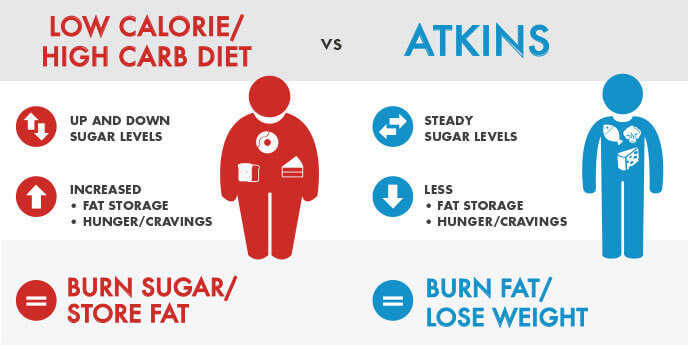
Basically, the Atkins Diet attempts to limit your body’s carbohydrates intake so drastically that your body stops burning carbohydrates as its main source of energy and starts burning through its fat stores. This process is called ketosis.
Ketosis, though, is only one reason why the Atkins Diet is so successful.
In his book, “New Diet Revolution,” Dr. Robert Atkins argued that not only does the body expend more energy while in the state of ketosis, but the diet also helps to suppress appetite.
Dr. Atkins believed that proteins and fats would help the body feel more full. If true, the Atkins Diet is a double-whammy of decreased caloric intake and increased caloric usage.
However, most notably from the medical journal “The Lancet,” several arguments suggest that dieters consume fewer calories on the Atkins Diet due to culinary boredom.
The Atkins Diet uses a series of phases, which will be discussed at length in a moment, to bring your body into a state of ketosis.
This is done by replacing foods in your diet that contain large amounts of carbohydrates with foods that contain low amounts of carbohydrates or even zero carbohydrates.
What research has to say?
Many scientists and researchers believe that the human body has a natural disposition for accepting sugars and carbohydrates as its primary energy source.
In fact, these people believe that cutting out carbohydrates from your diet is unhealthy because you are essentially tricking your body into believing it is starving, which is why your body then switches to burning fat.
Many studies conducted for more than 12 years have shown that low-carb diets are very effective in weight loss and various health improvement. Some of the studies are listed below:
- A low carbohydrate diet is compared with a low-fat diet in severe obesity, New England Journal of Medicine, 2003.
- Trial on a low-carbohydrate diet for obesity, New England Journal of Medicine, 2003
- Effects of a low-carbohydrate diet in overweight adolescents, The Journal of Pediatrics, 2003
- A trial comparing very low-carbohydrate diet and a calorie-restricted low-fat diet on weight loss and cardiovascular disease on women, The Journal of Clinical Endocrinology and metabolism, 2003
However, it has been argued that Inuit people lived on a diet that would have been ketogenic, and ketogenic diets have existed throughout history due to severe environmental and societal changes.
Once your body achieves a state of ketosis, the Atkins Diet suggests that you slowly increase your carbohydrate intake until you find the number of carbohydrates you can consume while still maintaining weight loss.
The number of carbohydrates at which this occurs differs from person to person, and an individual may, in fact, lapse out of a ketonic state.
However, a person who undertakes the Atkins Diet will still be consuming far fewer carbohydrates than the average person. This, combined with a regular exercise plan, can lead to dramatic weight loss and much better health.
Atkins Diet Phases
The Atkins Diet comprises four phases: Induction, Ongoing Weight Loss (OWL), Pre-Maintenance, and Maintenance.
Phase 1 – Induction Phase
In Phase 1, known as the induction phase, you choose from a restricted diet, including primarily proteins and vegetables, limiting your net carb intake to only 20 grams daily.
This restricted diet encourages your body to begin burning fat to produce energy, resulting in rapid weight loss.
The foods in Phase 1 contain nutrients such as minerals, vitamins, fiber, and antioxidants that will nourish your body as it becomes accustomed to a new way of producing energy without relying on carbohydrates.
The Atkins Diet begins with a limited menu of choices in Phase 1 and then expands in the other three phases, allowing most people to maintain their initial weight loss.
Phase 1 can last from two weeks to a few months, depending on how your body reacts to this new food intake style.
Many people find that they lose significant weight in the first 2-6 weeks of the induction phase. This occurs as a result of ketosis, the body’s shift into burning stored fat.
However, because every individual is different, it could take some time to reach your goal weight, even if you enjoy rapid weight loss in the first few weeks.
Phase 1 lasts until you are within approximately 15 pounds of your goal weight. It is recommended that most individuals should stay in Phase 1 until they no longer experience carb cravings or feelings of extreme hunger between meals.
What and how to eat in the Induction Phase?
In Phase 1, you will be eating regularly scheduled meals, either three meals of normal-sized portions or up to five smaller meals each day. Ideally, you should avoid going for more than six hours without having something to eat.
Every meal will include between 4 and 8 ounces of protein-rich foods from the list of acceptable meal items, ranging from fish, beef, poultry, and pork to eggs, certain cheeses, and some vegetable proteins.
Stay away from processed meats like bacon and ham, containing added sugars, and any meat products containing nitrates, such as cold cuts.
For a complete detailed guide, you can follow the guide on Top 10 Processed Foods to Avoid and Good Tasty Alternatives.
The Phase 1 menu also includes between 12 and 15 grams each day of low-carb vegetables, such as cucumber, mushrooms, peppers, romaine lettuce, and iceberg lettuce.
Other vegetables are slightly higher in carbs, but you can include them as part of your total 15 grams per day. These include olives, asparagus, avocados, broccoli, tomatoes, and zucchini squash, among others.
During Phase 1, you can use sugar-free sweeteners such as Splenda (also called sucralose), xylitol, stevia (also known as Truvia or SweetLeaf), or Sweet’N Low (also called saccharine), including up to three packets of sweetener in one day. Diet sodas containing these sweeteners are also acceptable.
However, stay away from other sweeteners such as honey, maple syrup, high fructose corn syrup, and molasses. Be aware that most salad dressings and other condiments contain sweeteners; always read the ingredient label.
Primary Goals in Phase 1
There are two primary goals in Phase 1 of the Atkins Diet.
The first goal is to train your body to produce energy by burning fat rather than carbohydrates.
The second goal, which will occur due to the burning of your body’s fat reserves, is to get a quick start on weight loss that can be maintained in Phases 2, 3, and 4.
The induction phase limits the type and amount of food you consume to accustom your body to a new eating and processing food.
Phase 2 – Ongoing Weight Loss (OWL)
Phase 2 of the Atkins Diet is known as ongoing weight loss. In this phase, you will continue to lose weight at a slightly slower pace than in the induction phase.
Your food options in Phase 2 include nuts, berries, and yogurt. Also, the total net carb allowance per day ranges from 25-45 grams. In Phase 2, you will discover your body’s tolerance for certain types of carbs.
In general, it’s best to add new foods gradually to give your body a chance to adjust to the new menu, which can also include some dairy foods and certain fruits.
This phase can be relatively short, depending on your body’s reaction to the new menu. Most people move on to Phase 3 once they are within 10 pounds of their goal weight.
The average person loses about two or three pounds per week while in Phase 2. If your weight loss suddenly drops off or stalls, stay in Phase 2 for as long as it takes to begin losing weight again. It’s also appropriate to stay in this stage if you are experiencing specific food cravings.
What and how much to eat in Phase 2 – Ongoing Weight Loss (OWL)?
Every food that was allowed in the induction phase is still acceptable for eating during Phase 2. This includes various proteins, like fish, beef, eggs, and chicken; many salad vegetables, such as lettuce and cucumber; some types of cooked vegetables, including squash and broccoli; and some kinds of cheese.
Certain new foods can also be introduced a few to build up slowly by about 5 additional grams of carbohydrates daily.
Some lower-carb dairy items are now allowed, include low-fat cottage cheese, mozzarella cheese, and ricotta cheese. Many nuts can be added, such as walnuts, almonds, pecans, and sunflower seeds.
Acceptable fruits during Phase 2 include fresh blueberries, strawberries, or raspberries, as well as honeydew melon or canteloupe. One 5-gram serving sizing of any of these fruits is about a quarter of a cup.
You can add small amounts of lime or lemon juice to foods at this point. Tomato juice is also allowed in Phase 2.
It’s important to be aware that many people have a “trigger food” that they can’t enjoy in Phase 2 because it creates cravings for those individuals.
A small portion of the trigger food might lead them to binge. Some people choose to keep avoiding their trigger foods in Phase 2. Another way to handle this problem is reducing your overall carb intake by a few grams, staying to the lower end of the 25-45 gram range.
How to measure your progress in Phase 2?
Remember, there can be multiple ways to measure how much weight you’re losing. Some people find it more helpful to step on the scale weekly, rather than every day, due to minor weight fluctuations from day-to-day progress.
Additionally, notice other ways to measure your progress. Your weight loss might be more noticeable when measured in inches rather than pounds. Your clothes may feel looser, and you might have more energy than before.
The primary goal in Phase 2
In Phase 2, the primary goals are to lose weight and feel in control of your appetite. This phase is a way to gradually and safely add more variety to your diet.
However, it is best to view this phase of the Atkins Diet to take baby steps into a broader food choices menu. It is most effective for most people to increase their net carb intake by only about 5 grams at a time to continue losing weight in Phase 2.
Phase 3 – Pre-maintenance phase
Phase 3 of the Atkins Diet plan is called the pre-maintenance phase.
Typically, when you are ready to move into this stage, you are only about 10 pounds from your goal weight. You can now increase your net carb intake to between 50 and 75 grams per day and continue to expand your menu options, including a variety of fruits and legumes.
It is reasonable to expect that your weight loss in Phase 3 might begin to progress more slowly. For many people, Phase 3 weight loss proceeds at an average of half a pound per week.
The length of time spent in Phase 3 is highly individual; it will depend on how quickly you can identify the ideal carb level and foods to maintain your chosen weight.
Typically, it takes a few weeks to reach your goal weight and experiment with your carb range. You will then need to maintain the goal weight for at least one month before moving to Phase 4. Some people like to consider Phase 3 as a rehearsal for maintaining their goal weight on a long-term basis.
What and how to eat in the Phase 3 – pre-maintenance phase?
In Phase 3, you can continue to enjoy all of the foods allowed in Phases 1 and 2. These include a variety of proteins, such as meats, eggs, cheeses, yogurt, and nuts, in addition to specific types of legumes and fruits.
Additionally, you can now add some grains, including half a cup of brown rice or one-third of a cup of rolled oatmeal. A greater variety of legumes are now available to you: black beans, lentils, chickpeas, great northern beans, pinto beans, navy beans, and lima beans. The portion sizes for legumes range from one-quarter of a cup to half a cup.
Acceptable fruit portions for this phase include half of red grapefruit, half an apple, one quarter-cup of cherries, one small banana, one small plum, a small peach, half a cup of watermelon, or half a cup of red grapes.
Half a cup of guava fruit or mango, or one kiwi, are also on the list of allowed fruits in Phase 3. You can also add several starchy vegetables now, such as baked potatoes, yams, and acorn squash.
Remember to keep an eye on your net carb range for each day, staying within the range of 50-75 that works best for you. A gradual increase of about 5 additional grams per day is the best way to up your carb intake in Phase 3.
The primary goal in Phase 3 – pre-maintenance phase
There are several goals in Phase 3.
First, continued weight loss at a slow but steady pace will lead you to your goal weight. Once you reach that weight, the Phase 3 menu will allow you to stay there comfortably.
Second, in Phase 3, you will experiment with finding your carb threshold.
Some people can go to the high end of the net carb range while still losing weight, and others find that they need to stay on the lower end of that range.
In some cases, individuals could discover that the carb level they enjoyed in Phase 2 is the best place to stay until Phase 4.
Third, you will find out which of the new foods work best for you; there could be one or two food items that you should continue to avoid until the last phase if they prove problematic for you.
Watch out for trigger foods—anything that you find it difficult to eat only in small portions.
Finally, one objective of Phase 3 is to maintain your ideal weight for one month before moving on to the last phase of the Atkins Diet.
Phase 4 – Maintenance Phase
Phase 4, also known as the maintenance phase, is intended to be a lifetime eating pattern.
Bread and other grains are now introduced to the available menu choices. Ideally, you have reached and maintained your goal weight by this time and will continue to stay in that range during Phase 4.
Having discovered the best net carb range for you during Phase 3, you will keep following that number while expanding your food options even further.
In this phase, you might even find that you can enjoy occasional off-menu treats as long as they don’t have a significant impact on your overall carb intake.
Unlike the Atkins Diet plan’s previous phases, the maintenance phase is where you are no longer “on a diet” but simply eating in a healthy and pleasurable way that works for you.
It has become a new lifestyle with multiple health benefits. Viewed in this way, Phase 4 is like saying goodbye forever to unhealthy eating and embracing your goal weight as the right weight for you.
What and how much to eat in the Phase 4 – Maintenance phase?
The list of allowed foods in Phase 4 is actually the same as in Phase 3.
Adjust your carb intake as necessary if you find that particular foods or portions don’t work for you in maintaining your goal weight.
By now, you can enjoy a wide range of foods. These include various vegetables, fruits, legumes, nuts and seeds, grains, and proteins.
Remember to continue reading ingredient labels on processed foods to be aware of hidden sweeteners, such as high fructose corn syrup.
It will also continue to be important to choose carefully when eating out. Keep in mind that you are in control of your food choices and your cravings. Stay within your net carb intake range for the best results.
In Phase 4, protein remains the cornerstone of the Atkins Diet. Unlike our natural urge to binge on carbs, it is much more difficult to eat too much protein, which lets our bodies know when we are satiated.
Protein is also processed differently by your body than carbs and provides a longer-lasting burst of energy.
In this phase, continue using nuts or berries to satisfy a desire for something that tastes sweet or crunchy.
Finally, continue to explore new ways to prepare vegetables to satisfy your taste buds.
Some people find it challenging to transition back into having occasional treats in Phase 4, such as on special days or socializing. It’s okay to indulge in a small portion of foods like this as long as you remain aware of your overall carb count.
If any particular food causes cravings or binging, take it off your regular menu for a while and find other ways to satisfy your palate.
The primary goal in Phase 4
Along with maintaining your goal weight and your new healthy eating pattern, one goal of Phase 4 is to notice any problems that occur and take steps to address them.
It’s okay to adjust your carb range or even revisit previous phases of the Atkins Diet as necessary to lose a little more weight.
Embracing the Atkins Diet maintenance phase means that you can avoid ever having to “diet” again, now that you’re enjoying a new healthy relationship with eating.
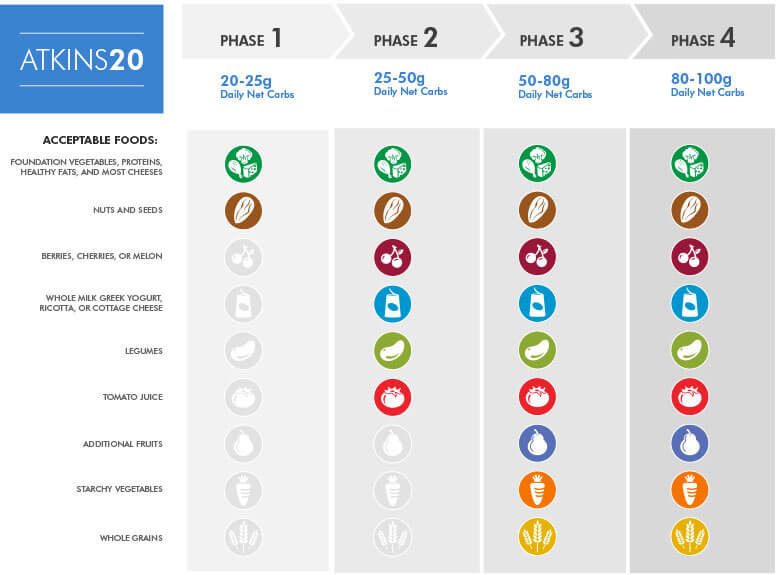
Atkins Diet Low Carb Food List
You need a safe, low carb food list to keep your body in the “Fat Burning” mode.
The low card food list is a useful guide for your Atkins Diet foods. All the food that is listed below is having carbohydrates 10% or less.
Meats
Lamb, Pork, Bacon, Beef, Calf Liver, Chicken, Cornish Game Hen, Duck, Goose, Ham, Kielbasa, Turkey, Quail, Sausage, Steak, Veal Steak.
Fish
Anchovies in Oil, Bluefish, Catfish, Cod, Flounder, Halibut, Herring, Mackerel, Mahi-mahi, Salmon, Sardine, Scrod, Snapper, Trout, Tuna.
Shellfish
Clams, Crab, Lobster, Mussel, Oysters, Scallops, Shrimp, Squid.
Dairy
Butter, Cheese, All Egg, Mineral Water, Mayonnaise, Tea, Water, Cream, Coffee.
Salad Vegetables
Cucumber, Boston Lettuce, Celery, Mushrooms, Olives, Parsley, Peppers, Chicory, Chives, Alfalfa Sprouts, Arugula, Bok Choy, Endive, Escarole, Fennel, Jicama, Mache, Morels, Posse Pied, Radicchio, Radishes, Romaine, Sorrel.
Vegetable
Brussel Sprouts, Cabbage, Cauliflower, Asparagus, Avocado, Spinach, String or Wax Beans, Summer Squash, Tomato, Turnips, Water Chestnuts, Zucchini, Bamboo Shoots, Bean Sprouts, Beet Greens, Broccoli, Celery Root, Chard, Christophene, Collard Greens, Dandelion Greens, Eggplant, Hearts of Palm, Kale, Kohlrabi, Leeks, Okra, Onion, Pumpkin, Rhubarb, Sauerkraut, Scallions, Snow Pea Pods, Spaghetti Squash.
Food not allowed in Atkins Diet
The Atkins diet is effortless, trusted, and straightforward and is guaranteed to work for most body types.
However, since the Atkins diet relies on the body going into a ketosis phase, there is absolutely no room for ‘cheating.’
The following foods will not work because though some foods are healthy, they all contain sugar.
Sugar intake is strictly prohibited in the Atkins Diet and will cause the body to fall out of ketosis’s fat-burning mode.
Instead, the body will use the sugars found in the following foods for energy and neglect its fat for fuel.
Moreover, fat content in food is of little concern to people on the Atkins diet.
The below foods are banned from the Atkins diet:
BANNED FOODS & BEVERAGES
MEATS
Deep-fried chicken, Breaded chicken/beef/liver, Corn dogs, Beef Wellington, Country Fried Steak, Meatballs, Veal parmesan
CARBOHYDRATES
Pancakes, Waffles, Rice, Bread, Chocolate, Cakes, Puddings, Crepes, Pita Pockets, Pasta, Beans.
Fruits (though some fruit may slowly be added after ‘ketosis’ mode has been obtained)
VEGETABLES
Any breaded vegetables are off-limits.
BEVERAGES
Alcohol, Soda, Milkshakes, Smoothies, Caffeine, Fruit juice.
DESSERTS & SNACKS
Potato chips, Cookies, Sugar candy, Ice cream, Muffins, Bagels, Cupcakes, Crackers, Veggie chips, Rice cakes, Processed hummus, Processed snacks type, Fruit chips.
Conclusion
The Atkins Diet has proven successful in helping many people lose weight.
Since dieters following this plan are allowed to eat rich foods like cheese, steak, and many other high-protein goodies, this diet is a popular eating plan.
Consulting with a trusted doctor is always advised before starting a new diet.
The Atkins Diet is still considered very controversial and should be considered as only one possibility of losing weight, along with other possibilities.
